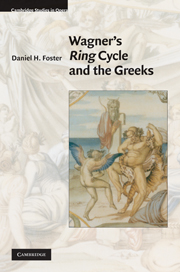Book contents
- Frontmatter
- Contents
- List of musical examples
- Preface
- Acknowledgments
- Introduction
- Part I Epic
- Part II Lyric
- 5 Introduction: what is lyric?
- 6 Orpheus and lyric liberation
- 7 First-person opera and lyric identity
- 8 Lyric and the rebirth of tragedy
- Part III Drama
- Epilogue: Time, the Ring, and Performance Studies
- Appendices: Wagner's primary and secondary sources
- Notes
- Bibliography
- Index
7 - First-person opera and lyric identity
from Part II - Lyric
Published online by Cambridge University Press: 07 May 2010
- Frontmatter
- Contents
- List of musical examples
- Preface
- Acknowledgments
- Introduction
- Part I Epic
- Part II Lyric
- 5 Introduction: what is lyric?
- 6 Orpheus and lyric liberation
- 7 First-person opera and lyric identity
- 8 Lyric and the rebirth of tragedy
- Part III Drama
- Epilogue: Time, the Ring, and Performance Studies
- Appendices: Wagner's primary and secondary sources
- Notes
- Bibliography
- Index
Summary
The journey of lyrical self-discovery that Siegfried embarks upon in his eponymous opera is also Wagner's own journey of self-discovery. But since music ostensibly lacks a first-person singular voice, as a composer Wagner has to be more indirect than the lyric poet who can simply say “I.” Through this simple grammatical act, literary poets can imply that both they and their characters are simultaneously the origins of the lines we read or hear. Yet, as a composer specifically of vocal music, Wagner was able to obtain some of this directness through the self-expressive advantage he had over composers of, say, absolute music. Like the lyric poet, his characters can at least sing “I.” And perhaps more so than in any other opera in the Ring, when characters in Siegfried say “I” it is Wagner we hear ventriloquizing through them, trying to express and exorcise the demons that haunted him concerning his own biological origins and his art; specifically, those bourgeois Jewish demons that tormented him concerning his father's true identity.
WHO SPEAKS IN LYRIC POETRY?
There are two primary dangers associated with very traditional readings of lyric as autobiography and, in turn, the application of such readings to opera. The first danger is in identifying the character in a lyrical work too closely with its creator. The second is in overlooking the national dimension of lyric poetry.
- Type
- Chapter
- Information
- Wagner's Ring Cycle and the Greeks , pp. 140 - 156Publisher: Cambridge University PressPrint publication year: 2010



